(← previous entry ←)
Mitraniketan
My friends Vicki Robin and Duane Elgin had visited Mitraniketan (mitra = friend, nikaten = abode or home) years ago and found it exceptionally inspiring – which led me to contact the school. Unfortunately timing made it a truncated visit (booking flights can be tricky as some of the short hops such as to Pune have terrible connections and don’t run each day) – so sadly I wasn’t able to offer a short training to staff as we had hoped. At least I was able to leave them a copy of our new book, Practicing the Art of Compassionate Listening. We arrived on a Sunday which is a resting day – and a key staff person was away for the day. And then the headmistress had an unfortunate fall (bruised and needing stitches, but ok)… So our orientation and reception were limited and a bit rought. Fortunately a special program had been planned by a visiting guru from Trivundrum Guru Muni Nara Yana Prasad. There was singing, dancing, performances by students, a delicious feast (served on banana leaves)… and a very looong address (all in the local language of course) to the children by the guru (over an hour! The children remained very attentive!). I was able to chat with him later that day and he gave me the jist of his talk: you must develop yourself (I have learned India’s national motto is ‘know thyself’) and deeply understand-accept-support yourself as well as learning about the world and developing skills. Then you will have two legs to walk on as you travel through life: one of the self (wisdom), the other of knowledge.
We enjoyed lovely chats with the various volunteers (several couples from Germany, students from Germany, Finland & US) and had the good fortune of welcoming Lee Morgan, of Antioch, who has been a long time supporter (indeed, his father was present for the founding – in the 50’s I believe). Mitraniketan has a long history of innovation and wholistic education with a prescient emphasis on sustainability and environment, serving poor village children who otherwise would not have educational opportunity. Sadly, they are facing many challenges in the past couple of years: Ironically this arises from the recent great economic advances in India. As the economy, opportunities and wages have improved it has become increasingly difficult to attract and retain qualified teachers and staff. The campus is out in the countryside with no amenities – an hour from Thiruvananthapuram – so not a desirable place to live.
Pune
We left the school Monday afternoon in time to fly to Pune. We soon learned a few key lessons for domestic flights in India: avoid booking connecting flights on different airlines! There is no coordination between them – you have to pick up your bags and recheck them in. They each have different regulations, often land at different terminals, and have rather restricted weight limits – so we got dinged to pay overweight baggage – and, since the first flight was delayed – stressed for time to get to the second flight. The drama of connection was increased when the second flight refused to allow my walking poles to be carried – so after getting to security I had to back track all the way back to check in – and by then time for luggage was closed! Fortunately there was a dedicated attendant who promised to get it on to the plane – grabbed the bag and ran off… Kathy stood firm at the boarding gate till I ran back up … I was so happy to see those walking sticks come out of the baggage carrier! Truly we have had guardian angels all along the way on this trip….
Maher Communities
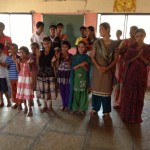
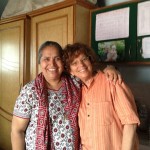
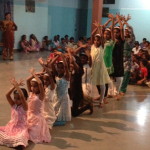
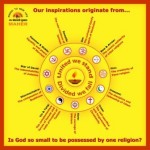
Upon arrival at Pune airport – we were welcomed with a sign saying “welcome dear Susan & Kathy’, along with wide open arms and a beautiful smile from the charming Gaus, a ‘product’ of Maher community, as he was taken off the streets out of child labor at the age of 8. Sister Lucy had insisted she send someone to pick us up from the airport. We were immediately bathed in the open-hearted, loving, compassionate energy of Maher (which means Mother’s home). We enjoyed an extraordinary time with founder Sister Lucy and the wonderful people and inspiring projects she has manifested. This is an organization worth supporting and nurturing. I have never experienced such pure love and joy radiating from everyone. And I learned deep, powerful lessons about welcoming. When we arrived at the Center – the blackboard had our names on it! … and inside there was a beautiful sand drawing (rangoli) with flowers and our name. The children sang to us, swarmed us with hugs, marked our heads with the binde/spot of blessing sometimes yellow, sometimes red… always running down my forehead in the humid heat (– the nosepads on my glasses are now dyed red!). We soon learned this was a ritual to be repeated at every stop we made in visiting the various schools. And then, when it was the eve of our departure – even though we were such short timers of just a few days – we were again honored with our names written, gifts given, etc. Everyone is honored as special and unique – I was stunned to find we were given equal honoring to a 6 month volunteer who has helped to write a handbook. Sister Lucy’s love is unconditional and complete for everyone. And it spills over to each and every soul there. The healing power is so beautiful and potent…
Sister Lucy was inspired to begin this work when as a young nun she experienced a tragic incident in 1991. A 7 month pregnant woman came to her convent late at night begging for refuge from her violent husband who wanted to get rid of her to make room for another woman. Sister Lucy was not authorized to admit the woman and it was against convent policies – so she had to turn her away that night. She went to help her the next day but found out it was too late: the woman had been attacked by her husband – doused with gasoline and lit on fire… She visited the woman in hospital as she was dying… the baby as well was killed by the heat of the fire. Over the next few years of mourning and grief and with help of her mentor, Father Francis D’Sa, Sister Lucy catalyzed her grief and pain and resolved to do something for such battered women. With no resources and without the support of her order, she began offering refuge to women – and with the women came children. Over the years her community has grown to over 30 schools and centers and she has welcomed over 2300 women through the years. She lives her commitment that no one will ever be turned away.
The model is brilliant: the women are given love, unconditional acceptance and safety along with food, shelter and clothing… as they heal, they begin helping out with cooking, cleaning etc. and they are taught various trades of sewing, candle making and crafts. If they cannot be reunited with their families and choose to stay as part of Maher – they become housemothers to the children in the schools. Each group of children (boys separate from girls) has two housemothers – one to do the cooking, the other to do the laundry-bathing-cleaning, etc. So it becomes a self-sustaining and growing community of healing and love, with each new resident expanding capacity to accept more community members. Many women come to the center in need – and many children are dropped off or found by staff: orphans, abandoned children, children put to labor without schooling, slum children, unwed mothers (extremely taboo in India), mentally ill or developmentally delayed women found wandering the streets… All are welcomed. “There is always room for one more.” Many of the children prove to be star pupils, winning state prizes and competitions… and then out of love and loyalty choosing to contribute their talents and genius to the organization.
The food is delicious and nutritious, the singing plentiful. Each day includes meditation, yoga, martial arts, training in traditional dance as well as school studies as vital parts of the healing needed for these neglected and traumatized children.. The program is deeply spiritual (with a fierce commitment to interfaith) and values based. The children attend public schools with tutoring and extra curricular activities at Maher. At one large center, they house the mentally ill and developmentally delayed women each in their wing – plus a children’s wing – and they all intermingle for meals and community activities. What a healing, holistic community! They also work in the slums nearby – running a preschool and supporting/spawning dozens and dozens of self-help groups. One village school had started 97 empowerment groups – nearly 50% of the communities entire population! (sort of like micro-lending groups). Maher, “Rising to New Life” – is interfaith, peace embodied – a living place of compassionate listening. My friend Anne Stadler was so wise in directing me to visit here: I learned so much and feel I have deepened my capacity for loving and listening through my short time there. Sister Lucy is the master and essence of compassion. There are growing pains now – as the impact of success and growth is stretching Sister Lucy and the organization to the max: they are beginning to develop as a model and training of others to replicate their system rather than continuing to expand.
For more details please enjoy the blog of a fellow volunteer, Pam Jensen: http://mahersupporter.wordpress.com/ Pam is also from Seattle and we are now working to create a Friends of Maher circle here (along with planning for Sister Lucy & Gaus’s Seattle visit in September 2013!)
–
After Maher, we spend a few days with a friend-colleague from Practice of Peace & Spiritied Work days: Arun Wakhlu was such a gracious host. We landed on his doorstep at this half point of our travels in need of laundry, post office, massage, pedicure-manicure, travel agent, bank, etc… all needs were met! This was my second Ayurvedic massage. The first one was the night of backwater boat trip in Kerala in a very primitive and backwater place… This was a nicer place with more skilled masseuse. Still – the table is made of HARD wood with no padding! I did request a towel for a bit of padding under knees etc. And this time, two young women worked on me simultaneously in a kind of choreographed routine. They slather you in think, warm, medicated oils and do many swooping motions up and down your limbs and body, with some more focused massage as well. No draping or cushions. Followed by a steam: you sit in a sort of cabinet with your head out… In the backwaters I added the treatment where they pour oil on your forehead: a flow down a wick, that felt like the wings of an angel or eyelashes of God… very relaxing.
Pragati Leadership
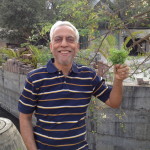
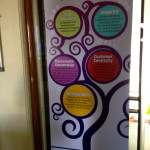
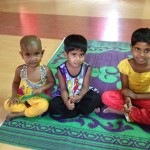
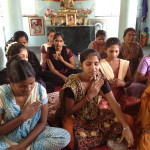
In Pune we had a chance to visit Arun’s inspiring organization, Pragati Leadership – which does training and organizational development very similar to what I do. He has built an impressive organization with a large staff. We joined their staff potluck lunch and I shared some simple exercises, which they greatly appreciated for team building and personal benefit. I led a simple meditation on self compassion and appreciation. I also taught one to use ‘on the spot’ – ‘3 Breaths’ – first for self, second for client or patient or team, third for community or world: just in that minute of 3 breaths you can ‘reboot’ and shift your energy to equanimity and compassion. (Try it right now!!). And I gave everyone our Conversation Café card and explained the process. They were familiar with World Café and were delighted to gain another tool and understand some guidelines as to when to use which… It was delightful to get to share with colleagues!
That afternoon we got to see some of the great work Arun’s family foundation is doing – working with individuals in the slums, teaching leadership, vocational guidance and coaching for entrepreneurship. They encourage individuals to consider what they like doing – what they have a passion for – and to develop a career plan, rather than just taking any short term job that comes along. For example, they notice with the rising of the middle class and economy, many gyms are being built and there is a need for personal trainers – so they are helping some young men and women who love physical exercise to get that training. We met with two groups of women who are learning to make jewelry – and in the process, developing confidence and a support group. When asked how many would never leave the house before this opportunity (other than to go food shopping at the side of their husband) – nearly all the young women raised their hand. So this work is life changing indeed. They were thrilled to get to practice their sales techniques when I of course agreed to make a number of purchases!
It was wonderful to spend time with Arun – a kind, thoughtful and deeply spiritual person as well as a gifted teacher. I will never look at a table cloth the same – as he uses it as a teaching metaphor for how we are all of the same cloth – all consciousness – all life – the cloth…. The various items on the cloth are an illusion of separateness – the plate of you/me, the cups and saucers of Islam or Christianity or Hinduism, etc. Arun schooled us in some basic Hindu principles, stories and history. For example, Krishna’s flute as a metaphor for us all: it must be completely empty inside – no spec of dust – or no tone can come… Surrender! Let go of attachment! Shakti & Shiva… the particle and the wave… Lovely chats. We also learned about the miracle tree – richest source of nutrition: known as horse radish or drumn stick tree – Moringa Oleifera. Check it out!
The Caves of Aurangabad – Ellora and Ajunta
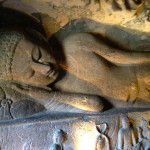
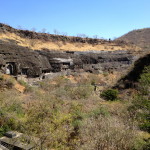
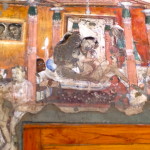
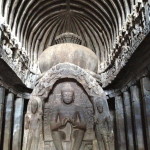
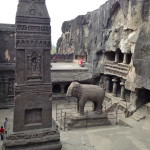
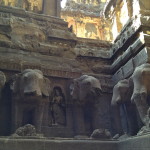
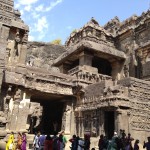
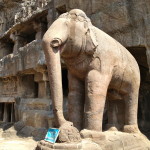
We left Arun’s loving care and headed to Aurungabad where we were awed and wowed one day at the stunning Ellora Caves (34 caves with ornate carvings – Buddhist, Jain and Hindu – over a 2km area – 600 to 1000 AD) and the next at more ancient Ajunta Caves (30 caves with exquisite Buddhist paintings and carvings from as early as 2nd century BC). Both of these areas were carved out of monolithic rocks into an astonishing array of temples and monastic dwellings. Ellora was carved from the top down. Ajunta – from the outside in… None are caves at all, but chambers carved out of solid rock with chisel and hammer. Unfathomable work. The paintings use sophisticated and realistic techniques of perspective, coloration, detailed representation of daily life as well as of stories from Buddha’s life. Truly World Heritage sites.
We were a bit cranky with our hotel in Arungabad– booked by Arun’s agent. “The Gentleman’s Hotel” was at the outer edge of town rather isolated/surrounded by unsavory looking streets. Very run down – dusty, all plumbing leaking or non functional, grungy peeling walls, nothing attractive – seemed we were the only customers. But the guys who ran it were so super-attentive and kind and protective – our hearts softened. For example, on the second day we had our sweet driver drop us off at the Internet Café so he could finally begin his way back to Pune. We assumed we’d hail a rickshaw to get back to the hotel. After an hour, lo and behold the manager of hotel showed up to drive us back! Also, the hotel’s food turned out to be –as usual on this whole journey- excellent. Oh the food in India. We’ve scarcely had a mediocre meal, never bad and almost always FABULOUS. So many varieties of sauces and curries and chapatti-type breads. Wow.
Navdanya
Tonight – after a long and frustrating day of delays and thus missed flight connections – we are enscounced at Navdanya – the organization founded by my shero, Vandana Shiva, to preserve the seed and promote Earth Democracy. More on that in the next blog!
PS
Another favorite India Taxi story: our driver from the airport in Dehra Dun pulled over at one point and said, ‘just a few minutes please…’ He proceeded to do some shopping.. and after another 10 minutes of driving, pulled over to deliver the groceries to his daughert! I love it: life is life and goes on, weaving its way naturally – without the drastic separation of ‘work’ vs personal life.
(→ next entry →)

India Blog 11: The Planet’s Favorite World Heritage Site – Taj Mahal and other Agra sites
We headed out early towards Agra in an especially comfortable and spacious car for the three of us, arranged by a travel agent. Interesting that all the stops were now at much more upscale (and expensive) restaurants that were also filled with overpriced souvenirs to buy. I kind of missed our more low-keyed grassroots experiences.
We stopped at Fatehpur Sikri, built by Emperor Akbar, capital of Moghul empire during its hay day in the 16th century. This spot was chosen as the Emperor made a pilgrimage to a saint in hopes of a blessing for fertility so he would have a male heir – when his hopes were fulfilled, he moved the capitol and built this splendid City (such were the riches of Emperors), soon to become a ghost town as there were difficulties with the water supply. Akbar was a fascinating character: Muslim but extremely devoted to inter-faith (indeed, he developed a new religion called “Deen Ilahi” to try to synthesize all faiths. His palace included fabulous structures for Hindi and Christian as well as Muslim. Read more
India Blog 10: The Pink City of Jaipur and Ranthambhore National Park
Oh my. Jaipur was astonishing. Take a few moments to fantasize what a fabulously wealthy and artistic lineage of maharajas would create… and now multiple it up by several powers of ten and you may begin to imagine some of the wonders we saw. The older Amber Palace atop a mountain – multiple courtyards – a brilliantly designed system of air/water cooling and plumbing from the 16th century (and we thought we were creators of sustainability and environmentally responsive design???!!). Jewel, granite and mirror encrusted gorgeous designs everywhere. Suites for harems, administrators, billiards, relaxing, writing, dance-music performance, etc. etc. A floating garden. Another ‘floating’ palace – known as the Water Palace – not far away – where the sultan could relax and hunt ducks undisturbed… Fort with an incredible network of walls and watch towers that seemed like the China wall. And then – several centuries later, abandoning Amber Fort… and creating the City Palace in Jaipur itself with it’s adjacent astrology/astronomy center (Jantar Mantar – a garden like park setting filled with futuristic incredibly accurate structures to track time and stars – within 20 seconds!!) and the Wind Palace (Hawamahal) where the harem was housed in beautiful glory… One example to help you imagine the scale of life: in early 19th Century the Raj was going to London for a big exposition. He wanted to be sure to have enough water from the Ganges along for the trip and so had two enormous pure silver vessels constructed to take along – the largest silver containers ever made – about 6 feet tall and 6 feet in diameter… (When near the Ganges people fill containers with holy water to bring to their homes as we saw in Haridwar and soon in Varanesi) –And on and on. The old City is surrounded by a lovely crenellated wall and all is painted in a pinkish salmon tone thus Jaipur is known as The Pink City. We capped off our day of touring with a visit to Tiger Palace (Nahargarh Fort) – which floats high above the city with an incredible view. I hope you get to visit some day! Read more
India Blog 9: Holy Cities on the Ganges: Hardiwar & Rishikesh
(← previous entry ←)
Haridwar
Later that night we found our way to Haridwar and were happily ensconced in a lovely little hotel, La Casa (yes – a Spanish name though an Indian owner). Again we were adopted by all the staff who clucked over us like mother hens for every little need. At our first restaurant stop (ohmygod have I mentioned how amazing each and every meal is!) I made the faux pas of asking for a beer (we’ve only had 2 so far this whole month in India!). “We are a holy City; no beer!”
We loved the crazy bustle of the one main thoroughfare: ubiquitous honking, pedi-shaws, horse drawn carts, tuk tuks (motorized rickshaws), motorcycles, dogs, cows, donkeys, new cars, bicycles bearing every load you can imagine… A riot of color and sound – women in their gorgeous saris – men with amazing turbans… And then escaping down a sound street to quiet alleys with sleeping homeless, resting pilgrims – so many stands of various colorful prasad – here they use banana leaf ‘boats’ filled with flowers and oil lamps you can then float down the river. At the ghats many pilgrims kneeling at dawn and dusk to bathe, douse with the holy waters of the Mother, the Ganges – this is very near the source of the river, where it emerges from the Himalayas. Every dawn and dusk at one main spot (Har-ki-Pairi Ghat – the Footsteps of God) near a temple monks gather a huge crowd for ganga aarti (river worship ceremony) with chanting, cymbals, horns – huge candelabras, powdered color dyes – what a spectacle as pilgrims bathe and send off their prasad flower boats… They call to the crowd to great and thank and bless and receive the blessings of the Mother Ganges and all raise their hands… This is the place where Vishnu is said to have dropped some heavenly nectar and left behind a footprint. For Hindus, the place to wash away your sins.
…of course the other side of India invades this spiritual sweetness: there are the ‘crowd control’ police who blow their whistle and insure that people sit down or move to the back – and they at various intervals begin hawking for contributions to charity giving out little receipts. Hard to know if these donations go beyond their pockets… and hard to resist a uniformed official’s demands.
In Haridwar there are two temples high up on the hills – Mansa Devi and Chandi Devi: you take a cable car to get there. Once at the top of Mansa Devi (the wish fulfilling goddess) there is a warren of hallways filled with prasad sellers (candles-statuettes-pictures-flowers-incense) – and then a series of little alcoves, each with a monk and some different blessing process. (And the all important receptacle where you are to place rupees!). They give Tika (a dot on your forehead) – sometimes you kneel – some ask your name and sing or recite a blessing – at one station the old monk says a blessing over a thread and then you tie it around a post. Many of the pilgrims are transfixed and you can feel the depth of their experience. Yet on the other hand – it is crowded and pushy and many are insisting about the money… Our hotel staff friend bemoaned the commercialization of spirituality here.
At this temple floating over the City I experienced another encounter with Indians that has become familiar: there were a couple of darling young girls adorned with ribbons for their pilgrimage and they happily agreed for me to take a photo. Once I showed them – their whole family – dad, mom, grandma, auntie, little brother – all wanted to be in the photo… And then: they all wanted a photo with me. We have had so many people ask to have our picture taken with them! We hear some of these may show up on Facebook and other places – some with claims that we are actors or some famous person. Who would think it of 2 old ladies?!
Rajaji National Park
Next day we took a jungle safari to the outskirts Rajaji National Park (park was closed due to rain the night before) and made another wonderful new friend – from Modesto, CA. She had just come back from the Kumba Mehla where she bravely went all on her own. It was fascinating to hear of her experiences and the array of holy people and touts and shams that she met there. She was embraced by an ashram with their guru and under their wing was able to experience the deep spiritually present for so many – including heading to the Ganges several times to bathe as well as meditating. On the other hand, one encounter with a supposed holy man shockingly turned out to become proposition when he suggested they have sex… And, as for many westerners – it was difficult for her to manage the reverence and obeisance to the guru – a similar reaction I had amongst Amma’s supporters.
(Did I mention we sadly decided not to go to Varanasi this trip because we had heard it was vastly overrun with so so many people from the nearby Kumba Mehla? First on our list for our return trip to India for which we are already salivating!)
On our jungle safari – we just missed an elephant: fresh, steaming pile of manure, sounds of crashing through the jungle… but no glimpse. As well. We did see two kinds of kingfisher (one a deep rich red-brown, one bright blue), two types of bright elegant parrots, buffalo, peacocks in the trees, rhesus monkeys and lemurs, eagles, hornbill, martens, spotted deer, astonishing Banyan trees, etc etc. Lovely! Our guide was incredible at spotting the wildlife through vision and sound – so attuned to his home in the jungle… We did get to visit some working domestic elephants at the forest rangers’ station. Closely: indeed, we got sprayed with trunk snot! Fascinating to watch the elephants strip the bark off the tree branches they were given for eat: they only like the bark, not the leaves. What they can do with those trunks!
Rishikesh
Next day we headed to Rishikesh (made famous by the Beatles at the Maharishi Mahesh Yodi) and enjoyed our meandering down the narrow, steep wandering road lined with Ashrams, yoga schools, and souvenir stands. The suspension pedestrian bridge was quite a trip – swaying in the wind, packed with people, cows, monkeys, dogs, motorcycles… View of crazy many storied temple like buildings of the two oldest ashrams/yoga schools… We drove further way through the exquisite country side, up the rice-field terraced mountains to an old and reportedly very holy temple: it appeared nearly in ruins – again, a warren of dark, confusing passage ways with food and prasad vendors – then a courtyard into a series of little alcoves with the monks and their bowls of rupees… All very dingy and dirty.
We had an interesting conversation with one of our hotel staff who expressed his view of karma and the purpose of life – as fulfilling one’s duty. He advised we study the Bhagvad Gita which would reinforce this lesson – even should it require you as a soldier to kill your own relations – so long as it is the rightful duty. My struggle: if everyone thinks God is on their side, how do we ever know what is rightful duty?
From Haridwar to Jaipur
Our departure from Haridwar, which we’d come to love, was rather dramatic: we were waitlisted #1 and 2 for the train and had been assured this would be no problem – you can always get on since there are many no shows and cancellations. What we didn’t understand is that we had unwisely chosen 1st class AC and this has only a dozen seats or so, so there are no open options – better to choose 2d class AC. Our ticket was automatically cancelled when the train is ‘chartered’ with seat assignments about an hour and a half before departure… As our friendly staff uncovered all this – and mistakenly thought we were headed to some destination where a big festival was happening – they began saying we should just stay over another night and leave the next day – Kathy saying sure sure – I began freaking out: no way! Our stay in Jaipur would become way too short and I was so ready/set to move on… So with a staff we headed to the train station to try to plead our case… Went from one official to another – they tried to find a way – but no seats… I recalled there was another train that same day and convinced the staff-helper… Yeah! We –after much haggling and I believe some special ‘tipping’ — were able to get 2d class AC for a train later that night! Our hotel let us go back and use our room all afternoon, no extra charge – and they were so kind and apologetic for our stress…for which really they had absolutely no responsibility!
We enjoyed the train and slept quite well. Our compartment mate was a delightful young man from Jaipur, so he coached us on all the things for us to see. And I lucked out again: there was a western style toilet! With my cranky old knees it is a trial to manage the squat toilets: I have been so lucky and only had to struggle a couple times so far!
It was fascinating to hear our Jaipur friend’s experience in Haridwar: he is newly married but having to live separately this year as his wife finishes graduate school near Haridwar. This was one of their first times together without the extended family – and they were quite overwhelmed with the touts and the hawkers at the aarti ceremony as we were. They wanted to light the candle for their prasad-boat on their own, to really reflect on their blessing and take their time… but the seller insisted she light it and when they got to the river one of the uniformed guards got very pushy and grabbed there basked, floated it away and demanded payment …
So dear readers: good night for now: we are happily in to yet another chapter of this incredible journey here in Jaipur at a lovely heritage garden hotel… More on that next time!
(→ next entry →)
Rishikesh
India Blog 8: Uttrakhand – foothills of the Himalayas
(← previous entry ←)
We are enjoying our stay on Vandana Shiva’s farm at Navdanya – Bijavidapeeth (Seed or Earth University)… although sadly she is not here. Hopefully I will catch her in Delhi. Our first night was off to a very bad start: Kathy took a terrible tumble down two ill-lit and unexpectedly narrow steps as she left the dining hall to go outside to wash her dishes… She spent the night in wretched pain and then we spent the entire next day schlepping in to Dehra Dun to have an Indian hospital adventure (took all day – about 5 hours plus 1 hour journey each way). Fortunately the treatment was ultimately excellent – courteous, professional, effective…and inexpensive! About $30 for exam, x-ray, cast and medications! She has a slight fracture just above the elbow. The cast is extremely heavy – old fashioned plaster – but has relieved her discomfort. The pharmacy was quite a sight – with a jumble of boxes and staff climbing all over the place.
At Navdanya we learned about how they are offering education in organic farming to farmers all over India. So many have lost their traditional wisdom since the advent of the ‘Green Revolution’ in the 70’s. Navdanya teaches the importance of diversifying crops to avoid the risks and degradation of monoculture. They teach the wisdom of saving seed each year – whether there was a good crop or not, whether the particular crop will be planted that year or not – since Mother Nature adapts year by year to changing conditions. Especially with the great shifts of climate change – these natural seeds brilliantly adapt year by year. They teach a number of methods of saving the seeds: best is in a small woven container sealed with cow dung and mud. All of the buildings at Navdanya are also covered with this clay of cow dung and mud – an excellent insulator and natural pesticide. The farm grows many experimental crops – wheat, rice, vegetables, herbs.
The surrounding countryside is lovely – and wild: peacocks and monkeys abound. And wild dogs too: one of our volunteers took an early morning walk and got surrounded by a pack of dogs that became quite aggressive… she managed to climb up a mango tree and hung there quite some time till one of the Navdanya staff happened by to help! We also heard a story of a tourist in a nearby town getting jumped on by a number of monkeys when she was carrying some food!
The group of volunteers (US, France, Germany, Holland, Australia, Korea, Canada, India, UK) was wonderful. What a joy to make so many new friends throughout this trip. I celebrated my birthday in the traditional India way by offering candies to everyone: a sweet new tradition! I was also delighted to host a Conversation Café the first night when we enjoyed a fascinating conversation sharing stories about when we felt most nourished in our lives and reflecting on how we can create a world that feeds us in healthy, sustainable ways. The next day we extended the conversation to our struggles around consumption and the exploitation and pollution it typically entails: while we didn’t find many new solutions, we felt comforted to know we were from around the globe and all struggling and experimenting in similar ways: ‘transition town’ trials are bubbling everywhere.
The second night I offered a short introductory session on Compassionate Listening and was gratified with the loving and open response from our lovely circle of a dozen international visitors. It’s interesting to get the feedback that for Westerners, 3 minutes feels so very long to speak/be listened to without interruption (an exercise we do in pairs) – but for Indians it is way too short. The urge to fix and problem solve seems universal and everyone was grateful to learn the value of silent, loving holding of space for the speaker. The mediation on self compassion was also deeply received and appreciated.
We then headed to Dehra Dun and visited a most amazing Tibetan Buddhist Monastery – Mindrolling Monastery (!) with an astounding 35 meter Buddha dedicated to the Dalai Lama and a huge stupa. The enormous Temple was gorgeous, every wall covered with exquisite paintings, the hall filled with chanting monks and clanging cymbals and horns, scent of incense… holy, holy, holy. Om nama shivaya. Then we headed to the Forest Research Institute, training sight for national forestry service – housed at an enormous red brick colossus (larger than Buckingham Palace) — estate of a Raj who built this gigantic palace in early 1900s that now houses many museums and varied forests including a magical one of bamboo. We even had some time for shopping at the pedestrian bazaar and found a great sweater (it’s chilly up here in the mountains!) and lovely pashmina scarves… So hard to choose from the profusion of gorgeous cloths!!!
Mid afternoon we met with my friend Mary Jane’s friend, Chayya, who is the state director for Room to Read. What an extraordinary project! The founder, John Wood, quite his high level position at Microsoft to pursue his passion for Nepal and books: 15 years later, he has founded scores and scores of libraries and well over a million books in countries all over Asia and Africa. Wow! A brilliant model: here in India, they work with the government schools that provide the actual space for the library. Room to Read then stocks with books, provides training to all teachers and staffs, and sets up the system over a 3 year period to insure sustainability of the program. Books are color coded so any child can pick the right book for their reading level. Their goal is to cultivate joy and the habit of reading. They are much attuned to cultural appropriateness and have published many books using local writers and artists. I am so inspired by the power and success of this project!
(→ next entry →)
India Blog 7: Schools & Women’s empowerment centers with heart and soul
(← previous entry ←)
Mitraniketan
My friends Vicki Robin and Duane Elgin had visited Mitraniketan (mitra = friend, nikaten = abode or home) years ago and found it exceptionally inspiring – which led me to contact the school. Unfortunately timing made it a truncated visit (booking flights can be tricky as some of the short hops such as to Pune have terrible connections and don’t run each day) – so sadly I wasn’t able to offer a short training to staff as we had hoped. At least I was able to leave them a copy of our new book, Practicing the Art of Compassionate Listening. We arrived on a Sunday which is a resting day – and a key staff person was away for the day. And then the headmistress had an unfortunate fall (bruised and needing stitches, but ok)… So our orientation and reception were limited and a bit rought. Fortunately a special program had been planned by a visiting guru from Trivundrum Guru Muni Nara Yana Prasad. There was singing, dancing, performances by students, a delicious feast (served on banana leaves)… and a very looong address (all in the local language of course) to the children by the guru (over an hour! The children remained very attentive!). I was able to chat with him later that day and he gave me the jist of his talk: you must develop yourself (I have learned India’s national motto is ‘know thyself’) and deeply understand-accept-support yourself as well as learning about the world and developing skills. Then you will have two legs to walk on as you travel through life: one of the self (wisdom), the other of knowledge.
We enjoyed lovely chats with the various volunteers (several couples from Germany, students from Germany, Finland & US) and had the good fortune of welcoming Lee Morgan, of Antioch, who has been a long time supporter (indeed, his father was present for the founding – in the 50’s I believe). Mitraniketan has a long history of innovation and wholistic education with a prescient emphasis on sustainability and environment, serving poor village children who otherwise would not have educational opportunity. Sadly, they are facing many challenges in the past couple of years: Ironically this arises from the recent great economic advances in India. As the economy, opportunities and wages have improved it has become increasingly difficult to attract and retain qualified teachers and staff. The campus is out in the countryside with no amenities – an hour from Thiruvananthapuram – so not a desirable place to live.
Pune
We left the school Monday afternoon in time to fly to Pune. We soon learned a few key lessons for domestic flights in India: avoid booking connecting flights on different airlines! There is no coordination between them – you have to pick up your bags and recheck them in. They each have different regulations, often land at different terminals, and have rather restricted weight limits – so we got dinged to pay overweight baggage – and, since the first flight was delayed – stressed for time to get to the second flight. The drama of connection was increased when the second flight refused to allow my walking poles to be carried – so after getting to security I had to back track all the way back to check in – and by then time for luggage was closed! Fortunately there was a dedicated attendant who promised to get it on to the plane – grabbed the bag and ran off… Kathy stood firm at the boarding gate till I ran back up … I was so happy to see those walking sticks come out of the baggage carrier! Truly we have had guardian angels all along the way on this trip….
Maher Communities
Upon arrival at Pune airport – we were welcomed with a sign saying “welcome dear Susan & Kathy’, along with wide open arms and a beautiful smile from the charming Gaus, a ‘product’ of Maher community, as he was taken off the streets out of child labor at the age of 8. Sister Lucy had insisted she send someone to pick us up from the airport. We were immediately bathed in the open-hearted, loving, compassionate energy of Maher (which means Mother’s home). We enjoyed an extraordinary time with founder Sister Lucy and the wonderful people and inspiring projects she has manifested. This is an organization worth supporting and nurturing. I have never experienced such pure love and joy radiating from everyone. And I learned deep, powerful lessons about welcoming. When we arrived at the Center – the blackboard had our names on it! … and inside there was a beautiful sand drawing (rangoli) with flowers and our name. The children sang to us, swarmed us with hugs, marked our heads with the binde/spot of blessing sometimes yellow, sometimes red… always running down my forehead in the humid heat (– the nosepads on my glasses are now dyed red!). We soon learned this was a ritual to be repeated at every stop we made in visiting the various schools. And then, when it was the eve of our departure – even though we were such short timers of just a few days – we were again honored with our names written, gifts given, etc. Everyone is honored as special and unique – I was stunned to find we were given equal honoring to a 6 month volunteer who has helped to write a handbook. Sister Lucy’s love is unconditional and complete for everyone. And it spills over to each and every soul there. The healing power is so beautiful and potent…
Sister Lucy was inspired to begin this work when as a young nun she experienced a tragic incident in 1991. A 7 month pregnant woman came to her convent late at night begging for refuge from her violent husband who wanted to get rid of her to make room for another woman. Sister Lucy was not authorized to admit the woman and it was against convent policies – so she had to turn her away that night. She went to help her the next day but found out it was too late: the woman had been attacked by her husband – doused with gasoline and lit on fire… She visited the woman in hospital as she was dying… the baby as well was killed by the heat of the fire. Over the next few years of mourning and grief and with help of her mentor, Father Francis D’Sa, Sister Lucy catalyzed her grief and pain and resolved to do something for such battered women. With no resources and without the support of her order, she began offering refuge to women – and with the women came children. Over the years her community has grown to over 30 schools and centers and she has welcomed over 2300 women through the years. She lives her commitment that no one will ever be turned away.
The model is brilliant: the women are given love, unconditional acceptance and safety along with food, shelter and clothing… as they heal, they begin helping out with cooking, cleaning etc. and they are taught various trades of sewing, candle making and crafts. If they cannot be reunited with their families and choose to stay as part of Maher – they become housemothers to the children in the schools. Each group of children (boys separate from girls) has two housemothers – one to do the cooking, the other to do the laundry-bathing-cleaning, etc. So it becomes a self-sustaining and growing community of healing and love, with each new resident expanding capacity to accept more community members. Many women come to the center in need – and many children are dropped off or found by staff: orphans, abandoned children, children put to labor without schooling, slum children, unwed mothers (extremely taboo in India), mentally ill or developmentally delayed women found wandering the streets… All are welcomed. “There is always room for one more.” Many of the children prove to be star pupils, winning state prizes and competitions… and then out of love and loyalty choosing to contribute their talents and genius to the organization.
The food is delicious and nutritious, the singing plentiful. Each day includes meditation, yoga, martial arts, training in traditional dance as well as school studies as vital parts of the healing needed for these neglected and traumatized children.. The program is deeply spiritual (with a fierce commitment to interfaith) and values based. The children attend public schools with tutoring and extra curricular activities at Maher. At one large center, they house the mentally ill and developmentally delayed women each in their wing – plus a children’s wing – and they all intermingle for meals and community activities. What a healing, holistic community! They also work in the slums nearby – running a preschool and supporting/spawning dozens and dozens of self-help groups. One village school had started 97 empowerment groups – nearly 50% of the communities entire population! (sort of like micro-lending groups). Maher, “Rising to New Life” – is interfaith, peace embodied – a living place of compassionate listening. My friend Anne Stadler was so wise in directing me to visit here: I learned so much and feel I have deepened my capacity for loving and listening through my short time there. Sister Lucy is the master and essence of compassion. There are growing pains now – as the impact of success and growth is stretching Sister Lucy and the organization to the max: they are beginning to develop as a model and training of others to replicate their system rather than continuing to expand.
For more details please enjoy the blog of a fellow volunteer, Pam Jensen: http://mahersupporter.wordpress.com/ Pam is also from Seattle and we are now working to create a Friends of Maher circle here (along with planning for Sister Lucy & Gaus’s Seattle visit in September 2013!)
–
After Maher, we spend a few days with a friend-colleague from Practice of Peace & Spiritied Work days: Arun Wakhlu was such a gracious host. We landed on his doorstep at this half point of our travels in need of laundry, post office, massage, pedicure-manicure, travel agent, bank, etc… all needs were met! This was my second Ayurvedic massage. The first one was the night of backwater boat trip in Kerala in a very primitive and backwater place… This was a nicer place with more skilled masseuse. Still – the table is made of HARD wood with no padding! I did request a towel for a bit of padding under knees etc. And this time, two young women worked on me simultaneously in a kind of choreographed routine. They slather you in think, warm, medicated oils and do many swooping motions up and down your limbs and body, with some more focused massage as well. No draping or cushions. Followed by a steam: you sit in a sort of cabinet with your head out… In the backwaters I added the treatment where they pour oil on your forehead: a flow down a wick, that felt like the wings of an angel or eyelashes of God… very relaxing.
Pragati Leadership
In Pune we had a chance to visit Arun’s inspiring organization, Pragati Leadership – which does training and organizational development very similar to what I do. He has built an impressive organization with a large staff. We joined their staff potluck lunch and I shared some simple exercises, which they greatly appreciated for team building and personal benefit. I led a simple meditation on self compassion and appreciation. I also taught one to use ‘on the spot’ – ‘3 Breaths’ – first for self, second for client or patient or team, third for community or world: just in that minute of 3 breaths you can ‘reboot’ and shift your energy to equanimity and compassion. (Try it right now!!). And I gave everyone our Conversation Café card and explained the process. They were familiar with World Café and were delighted to gain another tool and understand some guidelines as to when to use which… It was delightful to get to share with colleagues!
That afternoon we got to see some of the great work Arun’s family foundation is doing – working with individuals in the slums, teaching leadership, vocational guidance and coaching for entrepreneurship. They encourage individuals to consider what they like doing – what they have a passion for – and to develop a career plan, rather than just taking any short term job that comes along. For example, they notice with the rising of the middle class and economy, many gyms are being built and there is a need for personal trainers – so they are helping some young men and women who love physical exercise to get that training. We met with two groups of women who are learning to make jewelry – and in the process, developing confidence and a support group. When asked how many would never leave the house before this opportunity (other than to go food shopping at the side of their husband) – nearly all the young women raised their hand. So this work is life changing indeed. They were thrilled to get to practice their sales techniques when I of course agreed to make a number of purchases!
It was wonderful to spend time with Arun – a kind, thoughtful and deeply spiritual person as well as a gifted teacher. I will never look at a table cloth the same – as he uses it as a teaching metaphor for how we are all of the same cloth – all consciousness – all life – the cloth…. The various items on the cloth are an illusion of separateness – the plate of you/me, the cups and saucers of Islam or Christianity or Hinduism, etc. Arun schooled us in some basic Hindu principles, stories and history. For example, Krishna’s flute as a metaphor for us all: it must be completely empty inside – no spec of dust – or no tone can come… Surrender! Let go of attachment! Shakti & Shiva… the particle and the wave… Lovely chats. We also learned about the miracle tree – richest source of nutrition: known as horse radish or drumn stick tree – Moringa Oleifera. Check it out!
The Caves of Aurangabad – Ellora and Ajunta
We left Arun’s loving care and headed to Aurungabad where we were awed and wowed one day at the stunning Ellora Caves (34 caves with ornate carvings – Buddhist, Jain and Hindu – over a 2km area – 600 to 1000 AD) and the next at more ancient Ajunta Caves (30 caves with exquisite Buddhist paintings and carvings from as early as 2nd century BC). Both of these areas were carved out of monolithic rocks into an astonishing array of temples and monastic dwellings. Ellora was carved from the top down. Ajunta – from the outside in… None are caves at all, but chambers carved out of solid rock with chisel and hammer. Unfathomable work. The paintings use sophisticated and realistic techniques of perspective, coloration, detailed representation of daily life as well as of stories from Buddha’s life. Truly World Heritage sites.
We were a bit cranky with our hotel in Arungabad– booked by Arun’s agent. “The Gentleman’s Hotel” was at the outer edge of town rather isolated/surrounded by unsavory looking streets. Very run down – dusty, all plumbing leaking or non functional, grungy peeling walls, nothing attractive – seemed we were the only customers. But the guys who ran it were so super-attentive and kind and protective – our hearts softened. For example, on the second day we had our sweet driver drop us off at the Internet Café so he could finally begin his way back to Pune. We assumed we’d hail a rickshaw to get back to the hotel. After an hour, lo and behold the manager of hotel showed up to drive us back! Also, the hotel’s food turned out to be –as usual on this whole journey- excellent. Oh the food in India. We’ve scarcely had a mediocre meal, never bad and almost always FABULOUS. So many varieties of sauces and curries and chapatti-type breads. Wow.
Navdanya
Tonight – after a long and frustrating day of delays and thus missed flight connections – we are enscounced at Navdanya – the organization founded by my shero, Vandana Shiva, to preserve the seed and promote Earth Democracy. More on that in the next blog!
PS
Another favorite India Taxi story: our driver from the airport in Dehra Dun pulled over at one point and said, ‘just a few minutes please…’ He proceeded to do some shopping.. and after another 10 minutes of driving, pulled over to deliver the groceries to his daughert! I love it: life is life and goes on, weaving its way naturally – without the drastic separation of ‘work’ vs personal life.
(→ next entry →)
India Blog 6: Ashram of Amma, a living saint… to Trivindrum
(← previous entry ←)
Astonishing to drive to the end of this little palm covered island and find several huge high riser – 13 stories! Amma attracts so many devotees they have had to build a number of dormitories. The Ashram is like a small village, with many shops, canteens and offices – only the old Temple with adornments. Amma wants the Ashram to be a place of the world – her sense of spirituality is love in action. Her NGO Embracing the World is embarked in an astonishing array of housing, tsunami recovery, hospitals, water projects, orphanages, schools etc. She is an incredible effective and efficient manifester. It’s hard for me to fully understand the notion of guru – but after learning about her life in the stunning video River of Love I am getting inkling: she seems to be a living saint, embodiment of the gods, essence of motherhood and unconditional love and compassion – day and night, tirelessly. While we were very glad we came – we decided just to stay a day: there is little happening on the Ashram without her here. And the various little shops or information or ecology centers have more closed hours than open. Our room was as basic as you can imagine: a mattress on the floor, two on little racks. Cement everything. No adornment of any kind. Dingy but clean. Couldn’t open the windows so it resembled a prison cell. I loved the meditation on the beach and the evening chanting. Though I can’t imagine what it would be like with 10,000 people: just with the 1000 we had to queue up and wait quite a bit to get the elevator to our place. Tiny elevator for 5 maximum (if no luggage) – the second elevator broken. I made many friends on the sloooow ride which typically stopped at each floor in the sweltering heat – using all my languages speaking in Spanish, French, German… I think this is the point of ashram life here: turn each challenge into an opportunity for meditation and love.
On our drive to the Ashram we stopped at a fascinating temple of the Cobra. Here people bring their babies or selves for a blessing of gratitude for new life or health or some answered prayer by paying their weight in whatever they can afford (rice, fruit, etc.) –they are in a scale and put the offering in the other side to balance. We were fortunate to witness such several rituals. And a man with a flute will sing a prayer with your name for a small donation; the flower garland makers will place one with a prayer for you; and a monk will say a special blessing for requests such as fertility or health… Such a living temple, with families, energy, activity – and of course snacks for the family. Lovely
The rest of the trip was a rough journey: this taxi driver was the opposite of aggressive and kept getting lost… But eventually we found the Ashram. The driver the next day to Thiruvananthapuram (Trivandrum) was efficient and we now appreciated the need to ‘drive by horn.’ Once in town – we joined another delightful home stay: our host and his wife fed us wonderful Keralan food. I love the breakfast: you have some sort of wonderful crepe or chapatti base (one day it was ‘strings’ of rice noodles in a little patty like nest) with yummy curried Sambar – green mango and onions – to go on top. Today it included a hardboiled egg.
We stopped to see the Shri Padmanabhaswamy Temple – quite ancient for the first two levels (5000 years!) – with many ornately carved stories added in 18th century. It is one of the holiest Hindu sites in all of India, known as its spiritual heart – not open to visitors. We learned there is a huge (like the size of a building) reclining Vishnu statue with serpent. And they recently discovered three treasure chests: they’ve only opened one and it contained TRILLIONS of rupees worth of treasure – gold, jewels, etc. The place is heavily guarded and there is great controversy about what to do with this unimaginable fortune. This is adjacent to the Puthe Maliga Royal Palace. It’s only 200 years old and built in exquisite ornate lavish detail: each ceiling carved in unique intricate Rosewood patterns. Outer windows supported by ‘happy horse’ heads. Stunning life size statues of characters from Kathekali. A huge throne made of intricately carved ivory (from hundreds of tusks) and another huge throne made wholly of crystal. Wonder after wonder.
After a wander in the bazaar, we took a rickshaw to get out of the sweltering heat for lunch and managed to find a fanned India coffeehouse – a cooperative worker-owned small chain: we found the one in a windy little tower where you walk up the rather steep winding ramp and find the booths along the side – the walls in open brick – all the waiters in nifty turbans with a peacock like twist. Charming!
Later we went to the Zoological gardens (served as basis for the film, Life of Pi) … in a lovely park like structure, but the enclosures made us sad for the animals. And too too hot and sweaty!
The peak of our time in Thiruvananthapuram was a dance recital our host took us to at a local government run Cultural Arts Center. The young woman provided to be a magnificent dancer of classical Indian dance – Kerala style I suppose. Her every gesture and facial expression was the most expressive I have ever seen: every moment a specific position of eyebrow, eyes, lips, head position, hands in mudras – feet… etc. We could ‘read’ the text of every moment of the story of the dance. And she was so exquisitely beautiful. Her first piece was a welcoming opening where she clearly let us know how special and precious we, the audience, were to her and the deep importance of this moment for her in her life. One of my favorite pieces was her tender loving care of an infant … who then became a testy toddler she adoringly reined in… then a young child… who was gradually becoming more independent and leaving her loving embrace. Oh my – she reached so deeply into the vastness of maternal love and the connection with the child – the joy – the adoration… I was so deeply touched. When she did the final piece, now thanking us in the audience, expressing her gratitude and gratification (all of course only with movement – no speech)… I was in tears. She seemed like a beautiful flower at its moment of peak bloom – clearly having spent her whole life since a young young girl to reach this perfection… Her beauty and perfect body and grace – fragile – short lived… Her dance so deeply from the heart… Her focus and concentration so purely attuned from the spirit level. Wowowowowowow.
This wonderful evening of dance was capped with a homemade Keralan feast back at our Guest House – where we were joined by a new friend Sabine who we met in Cochin. And of course Li Lu.
Dear readers: what you must know is I haven’t written about all the little challenges and frustrations – of negotiating every taxi or rickshaw; the difficulty the drivers seem to have in finding anything – no maps or street names – just stopping to ask every few minutes – or when a phone is known for the destination, calling for updated directions every 5 or 10 minutes. The wrong directions so often given. The ambiguous head bobbles (was that yes? Ok? Maybe? Keep going?) The many wild goose chases if looking for something specific – such as the Vodafone Service Center (for some reason my phone won’t let me send text messages, only receive them… Texting is important since there is no voice mail.) This all part of the adventure and cross cultural experience. I am turning each moment into a meditation and developing hearty ‘surrender’ muscles…
(→ next entry →)
India Blog 5: From charming Fort Cochin into the paradise of the backwaters of Kerala
(← previous entry ←)
We are in paradise – but oy oy oy so hot and humid. We enjoyed our days in Fort Cochin – old alley ways and winding streets, zillions of hyper-active shop keepers (with signs protesting ‘hassle free’ – gotta be some of the world’s best salesmen!). A favorite activity was going to see a fascinating historic theatre style unique to Kerala called Kathakali: the actors use gesture, body posture, incredible eye movements and mudras to tell the story. The make up process takes about 1.5 hours where the actors use natural elements in 4 basic vivid colors: red, yellow, white and green. Some of the characters have additional features made of rice paper mache ‘glued on’ with coconut paste. We began the evening by observing this fascinating process. To think the actors do this every night! For them it is a ritual and meditation as well as preparation of costume, so they are ready to act out the sacred texts of the Mad…. The theatre was such a sweet space – intimate, made of beautiful old mahogany. (And our wonderful host from the hotel got us front row seats.) They prepared the space in such a beautiful way before our eyes – adorning the statue of Vishnu and Kali with flowers, drawing mandalas on the floor, etc.
After the play we were fortunate to enjoy a concert of traditional ragas – wonderful sitar and __ drum. This little arts center is dedicated to preserving-renewing Keralan traditional arts. I was so inspired I returned the next day to watch the traditional style of martial art (kalarippayat), which up to about the 16th century was learned by all youth (boys and many girls as well). Indeed it seems the roots of ayurvedic medicine came from the skills of the martial art teachers in healing the many cuts and broken bones their students would acquire from this fierce form (sticks, swords, knives and a wicked long curling lasso like weapon that is like barbed wire: outlawed now except by license to advanced practitioners of the art!). During the demonstration my arm was slightly burned by a spark flying off the stage during the knife fight! The real stuff. Fortunately there were no mishaps!
Cochin (also known as Kochi) is definitely the most touristy place we’ve been – but rightfully so. So picturesque and pleasant by the sea. Huge butterfly nets for fishing in the Chinese style (apparently the only other place in the world outside of China where this is used. Here it’s a legacy of Kubla Khan from 14th Century) We were fortunate to be there in time for a fabulous first-time international Biennial art festival with incredible contemporary art exhibitions by Indian artists from through the country and some from expats living abroad. Very stimulating and innovating. As all of India – a delight for the all the senses – an amazing interactive mobile making different sounds; one with spices/scents. Video, multimedia installations. The most powerful I saw: a wall with little shelves holding rice – one for each farmer who has committed suicide (because of the devastating debts they incur when they get seduced into using fertilizers and new style seeds that don’t reseed and soon require more and more pesticides)… with little books naming each one and including some photos. Many tears flowed; this breaks my heart (and then sends me into rage from which I need to work hard to calm myself).
The food everywhere is amazing – lots of seafood here. We made new friends – and have been delighted to be joined by a Seattle acquaintance for our week in the backwaters ..
During our days in Cochin we used the motorized rickshaw services of a very sweet guy, Samad, who was overjoyed to have the work (200 rupees for all day schlepping us, waiting, taking us point to point etc. which is $4). He hadn’t had any work for 3 days and supports his family of wife, two kids, and mother – rent of 3,000/month ($60). What a wonderful luxury especially in the heat: we didn’t have to walk and get lost and ask directions and he knew of several interesting extra spots – like a big laundry that looked like something from another century: wash on stones; dry on pinless ropes (twined so clothes could be tucked in); pressed with coal heated irons!
Interesting post office experience: we decided to ship by everything we could to lighten our suitcases. We had to have a special cloth cover tailored to cover and seal the box for shipping. Hopefully it will arrive before I get home!
We splurged with our friend Li Lu Porter from Seattle (recently retired from Microsoft and studying Yoga here) and rented a traditional houseboat for an overnight in the lagoon/canal areas: beautiful relaxing cruise through the backwaters – so many beautiful birds – bright blue kingfishers, many cormorants and egrets, black-white-grey birds, songbirds, parrots (we would call parakeets) – and many many coconut palms, banana trees, mango, papaya, green green rice fields, charming little houses along the narrower canals – painted vivid colors. Serenaded by the birds and the slap of women washing on stones. Everyone so friendly – thrilled to wave and smile back at us, happy to pose for photos. The boat comes with a great sitting area of couches/chairs in the open air at the front – a dining room – kitchen (with a FABULOUS chef) and two bedrooms each with great bath!! Li Lu had a friend who helped us book this boat – a new one in the traditional style but made low and narrow enough to get under the bridge and go into the smaller canals vs. most of the bigger boats. Our guy chose a route that kept us from the more crowded areas. We saw lotus flowers in the morning – our crew managed to pick a few for us: so beautiful. For dinner we ate the local state fish which was a bit heart wrenching after learning about these remarkable creatures: they mate for life and have a very affectionate and loving relationship, gazing into each other’s eyes. They care for their young together for some time till the babes mature. The only drawback is knowing that this growing tourist trade is adding to pollution here in the fragile environment. There is an eco-tourist resort experimenting with solar powered boats.
And now we are in another paradise: Mankotta Guest House outside of Haripad, a small village in the backwaters south of Allepey. The couple, Jai and Sarah, are so welcoming, speak impeccable British English and are exceptionally knowledgeable about the history and culture, both coming from local families and with long, rich and esteemable histories. Their plantation was developed by Jai’s grandmother (she sounds like one of kind!) Her husband was a prosperous lawyer in Trivandrum but she preferred the country and came here to develop it on her own – building up the land for (as you dredge, you build up the mud to create land mass as an island) and building the house alongside the rice fields. Originally they had ~300 acres but once the communists came into power in the 50’s no one was allow to have more than 15 acres, so they sold most of it off. In the 90’s, when Jai’s mother died, he realized he was the only son still living in India and felt called to return to the land and so made early retirement from his naval career. They continue growing rice as well as coconut, bananas, jackfruit and some vegetables. In 1996 they decided to begin to welcome some house guests as they converted some of the no longer needed out buildings. We are sharing a fabulously large room with a sitting area facing the canal lined with palms and trees and a chorus of birds, occasional call from the nearby mosque. So peaceful and beautiful. (NOTE: The actor Jeremy Irons once stayed here in our very room!!)
Here at Mankotta I feel like we are getting a private course in history. For example, she says the high rate of literacy and economic justice in Kerala has nothing to do with having been Communist – in fact, the early communist party was brutal and corrupt and violent. Jai’s father actually helped stem that trend: in the early days, they were so fiercely hostile to landowners they put lethal police out in the fields to keep the workers away… Jai’s father contacted a relative who was an Admiral who then sent some helicopters: the Communist Party got the message: they were not free to behave in any brutal way they wanted… There were ties to the National Government with accountability. We saw evidence of the wisdom of the early Rajas at the Dutch Palace in Cochin. For generations, they were progressive with a deep base of open hearted welcome and tolerance and value of education and equality – and a matrilineal culture where property and names came from the mother (husband taking wife’s name!).
Indeed, back in Cochin we learned that one of the Rajas granted the Jews of Cochin a kingdom!!! It was also a place of peace and acceptance for several hundred years – until the destruction of that kingdom (can’t recall the name – I sent the booklet home!) which some equated to the destruction of the Second Temple. It was fascinating to visit the old Pardesi synagogue in “Jew Town” in Cochin – from 16th Century – Chinese tile floor (each unique) and Belgium crystal chandeliers. Still in use today (though only 8 Jews in Cochin remain so they can only have a minion when visiting rabbis come – 30 Jews in all of Kerala – they all resettled in Israel but are reported to often come to visit and have all brought Keralan soil with them to Eretz Israel).
Creature sidebar: this afternoon while dining with our host we noticed a butterfly struggling inside – dangerously close to the fan. So our host stopped the fan (drip drip sweat sweat)… until the butterfly found its way out. This reminded me of our Auroville frog friend: one day I flushed the toiled and couldn’t understand why this one part wasn’t going down… as the swirling slowed I saw it as a frog frantically swimming upstream! Next day he popped out from behind the mirror!
This afternoon our hosts arranged for a staff person to take us canoeing down the canal – another taste of paradise, so quiet, with village houses and life all along the way again… And a thrilling surprise: we saw an elephant! It’s a working elephant posted at a government timber depot. He was relaxing, eating, swaying his trunk and smile very prettily for our many photos!
Our hosts have treated us like royalty::: salt-lime drinks in the garden upon arrival; tea with yummy biscuits brought to our room in the afternoon; cocktails on the veranda early evening – and a fabulous feast for dinner with unique and wonderful Kerelan dishes. Their favorite salad was marvelous: carrots roughly grated with apples, cilantro… hmm can’t recall it all – I will get the receipe! The dessert was definitely ‘to die for’: a creemay frozen conconut delight – between cheesecake and ice cream. I think the best dessert I’ve ever had. At breakfast we had the wonderful Keralan apam with an egg cooked into it – sort of a rice crepe – and their famous banana jam (written up in a magazine): never would have guessed it was banana just with jageri (local cane sugar) because it was the red color of pomegranetes! ., And I had hoped to lose weight on this trip! So readers: have you booked your ticket to Kerala yet?
Tomorrow we head for Amma’s ashram though sadly she won’t be there –she’s traveling in India.
(→ next entry →)
India Blog 4: Days of rest and reflection up in the hill town of Kodaicanal
(← previous entry ←)
Now up in the mountains between Auroville and Cochin – drinking in the cool clean quiet refreshing air. What a treat! Oh the air is so sweet and fresh here! We’re at 7,000 feet elevation and the change from hot, dusty, humid Auroville and Pondi is so welcomed. We are staying at the “Eco-Village Elephant Hotel” though were disappointed to learn this is the wrong time of year for many elephants (we had no luck) – but lots of monkeys, chorus of birds and frogs, beautiful flowers and trees.. The hotel is an organic farm and so we again had an abundance of fabulous veggies and fruits where we could eat everything. They proudly showed us how they produce coffee, pepper and various herbs.
We had a nice little hike to a falls – very low as there’s been little rainfall this year.
And then we hired a taxi to spend a delightful afternoon back up in the little town, meandering about. A sweet lake with old fashioned paddle boats, a stunning little walk at the top panoramic view– and an old Natural History museum at a beautiful Catholic missionary filled with taxidermy and relics from early 1900s when the French collected all the specimens. Once India became independent – they put a stop to any killing of animals. The guard was a charming, delightful priest who had lived in the Vatican as the Tamil translator for the Pope for many years. He loves Americans – I taped his effusive remarks so I can bring a smile to face whenever I need a lift and relisten!
By the end of our time we felt fully renewed, relaxed and refreshed – ready for the next adventures.
We hired a car and driver to take us through the beautiful tea plantation country down to Cochin and had a great day with stops at a family’s home where the owner of one of the largest spice farms showed us the samples of plants all around his house – tasting new fruits and spices like “masala leaf” that has the flavor of the 4 elements of garam masala – an egg fruit (didn’t care for it) – tree tomato (yum! Like a cross between passion fruit and pomegranate) – and many others. We saw how cardamom grows at the base of a tall grassy bush – and each seed has to be picked by hand. I finally got to see a cinnamon tree (very tall! Glad I discovered the panoramic option on my camera!). And at the end, the family welcomed us inside for cardamom coffee and fresh pineapple. Delight! Later we stopped at a Tea Factory to see how it is processed here. Then – winding our way down – a slight detour to avoid a strike which would have trapped us in the car… and into Cochin. Oy. It is so hot and HUMID here – but gorgeous and charming. Our hotel (called Delight Guest House), right in Fort Cochin, is truly a delight.
(→ next entry →)
India Blog 3: Auroville
(← previous entry ←)
One of the things that drew me to Auroville was my connection to an old friend, Madhabi: Over 20 years ago she stayed with me as young student volunteer with Cascadia Quest, an evolution of Peace Trees. I had such a deep heart connection with her which I am delighted to report is still there. Here is a picture of me with Madhabi – we have enjoyed many adventures now together and relished our reunion.
I have heard about Auroville for so many years: the first Peace Trees project took place there and Danaan Parry’s spirit is alive and known there. At Verite, the community where I stayed, there is a marker and a tree dedicated to him. (Danaan was one of my earliest mentors and teachers about peace building and citizen diplomacy and in that sense the spiritual father of Global Citizen Journey. It was upon his early and unexpected death that I resolved to carry on his work … which evolved to be GCJ).
The founding of the community was inspired by the work of Sri Aurobindu and his spiritual partner, The Mother. She was the amazing manifester who created the plan and attracted the people and guided the energy. I found Auroville fascinating and inspiring (and a bit disorienting as while it could only exist here in India, its dedicated host, it is not India!). It is complex and diffuse and emergent and self organizing… so takes a while to get a beat on. There are about 80 little rural settlements – each sort of an intentional community with a particular project. And about a half dozen Tamil villages are within the boundaries Over 40 nationalities. By the end of our week I was starting to get it. I will probably be back! They are fully engaged and devoted to a grand experiment that so intrigues me
Auroville’s heart is their amazing temple, the Matrimandir (the golden globe temple). My visit to the Matrimandir was one of the most extraordinary experiences I’ve ever had. Every detail of the grounds and building, inside and out, are exquisitely planned and executed to perfection – and brilliantly designed to open your heart and bring you deeply in touch with the soul’s deepest yearning for wholeness, purity, love, peace, aspiration to evolve to highest self… The globe is surrounded by lotus leaf shaped earth colored brick buildings, each of which is a meditation room, one for each of the core values (each with its own color to go with that value). You approach the globe by passing between two of these ‘leaves’, descending to bottom of the glove. The globe is made of golden disks (enough to represent all the countries of the world plus the states of India.) Beneath it is an exquisite white marble lotus. You enter the bottom of the globe (all in silence) and feel embraced as if inside the earth itself, with a golden glow embracing and holding you… There are four columns in this vast interior space, with water noiselessly flowing down in a ribbon of movement, its source mysterious. You begin to climb, rather steeply… midway you are on another level where everything is white… you put on clean white socks and continue the climb on white carpet – white marble columns… at last, you enter the meditation room – round – all white – cushions (and a few chairs if requested) placed symmetrically all around – with meditators sitting – At the center is a crystal globe seated upon stars of david (universal sign – “as above, so below”) – with a lotus at the base of the crystal… There is a beam of sunlight coming in from above reflecting on the crystal…. wowowowowowowow…. I was moved to tears, my heart so opened, so deeply touched…
Sadhana Forest project
One evening I went to Sadhana Forest project – an inspiring community started by an Israeli that is dedicated to sustainable living and reforestation. Every Friday they host open house, giving a tour, showing a film (like our Friday Night at the Meaningful movies!), and serve a wonderful veggie meal. I had heard the bus leaves promptly at 6 pm from the Solar Kitchen (the large community cafeteria where Aurovillians take most of their meals). I mistakenly thought the Solar Café at the Visitor Center was the starting point… and in a panic grabbed a rickshaw at the last minute to head over there at 5:50… Along the way a group of young folks was trying to flag the taxi to ask directions… I’m anxiously saying ‘we have to hurry’ – but when I heard them ask ‘Solar Kitchen’ I said, stop! Let’s give them a ride or they’ll never make it… so the 5 of them squeezed in our tiny vehicle, the driver with kind humor… (The kids were doubtful they could all fit: I told them I used to head to the beach in LA days with 16 kids packed in a car!!) When we arrived it turned out there was (why was I not surprised) a mix up and we’d have to wait for another bus… It turned out to be a great wait. The kids showed me how you use twigs of the neem tree to whiten your teeth. And Madhabi called me on the phone and said “I’m coming right now” and 2 minutes later she putted up on her motorbike: what a delicious embracing hug of reunion!
The Sadhana Forest project was very inspiring: they have innovated many methods to conserve water and support the new trees planted such that nearly 90 % of their trees survive vs. the usual 35%. Even the way they have set up to wash your hands and wash the dishes were carefully designed to maximize sustainability: For example, for the hands: You place a cup of water in a tin can with a small hole that allows a slow trickle, just right for soaping (100%biodegradable) and washing… the water is running off to feed a banana tree. They serve as an education center, with many volunteers getting trained – and they have projects going on in Kenya and Haiti. A very worthy cause – check out their website.
–
As I’ve learned about the struggles of this pioneering community – just 40 or so years old with only 2,000 permanent full time residents – it seems truly a miracle that they could have managed to not only design such a wonder but to manifest its completion to create this community dedicated to Unity and Peace for all of humanity.
(→ next entry →)
India Blog 2: Tirunvannamalai
(← previous entry ←)
Tiruvannamalai
Once we were out of Bangalore – we began to experience the India street scene: cars, motorcycles, cabs and humans laden with piles of sticks on their head etc. all adapt to the cows and dogs with loving care. An Indian friend (Arun, who we will visit later in Pune) suggested we visit the Ashram of Ramana Maharishi, known as the Archangel of Silence and Listening. How could I not stop there? So we traveled to Tirunvannamalai for an overnight en route to Auroville. We arrived in time to find a hotel and then walk to the lovely ashram. There was a palpable feeling of peace there. Everyone present held a space and energy of calm and reverence. As I sat in the inner temple of the shrine where Aruna achieved Samadhi (conscious exit from the body) and leaned against the wall, I was astonished to find the room felt like it was tilting and rolling… I check this sensation several times – moving away from the wall and then again leaning against. Some incredible energy was there for me.
Later that evening we entered the huge Arunachaleswar temple, The grounds are enormous (10 hectares), with 66 meter tall ( 13 storey’s) carved ‘pyramid’ shape structures at the four cardinal points and many buildings and temples inside. In all temples in India you have to remove your shoes… This then entailed several hours of walking on hard stone. Oy I have tender feet. We found our way to the first temple where you walk through a series of rooms, getting quieter, going deeper towards the sacred to the far end where a fire was burning tended by a large half naked monk who put an ash and red powder on our foreheads. This is a fire of burning ghee, dedicated to the fire destroyer incarnation of the Destroyer of the Universe – one of the important Hindu gods. We wandered through an area where a very loud and terrible sound system blared what seemed to be speeches honoring varying officials for some organization – the stage all lit up like a carnival. Next area there were families with children running around gaily, happily eating sweets sold there. Was this a temple or a park?!
Finally we realized we reached the main temple: there was a booth to buy a ticket for all of 20 rupees (35 cents). As we walked down the aisle bounded by metal poles we noticed many women on the other side so we thought, hmm, maybe we’re on the men’s side and we ducked over… The line soon slowed and became very dense. Dozens and dozens of people, including large groups of students, excitedly, noisily waiting. Some in beautiful red and yellow saris, male monks nearly nude, families with babies… Suddenly we saw a group quickly moving through the line on the other side: are they cutting or ?? Ah ha: that was the privileged pay line we were meant to be in! Ah well… We enjoyed interacting with the ‘plebeians.’ As we finally approached the end of the line there was another huge monk with a big naked belly handing out pinches of ashes… We could barely see into the inner chamber where the flame was kept: that was for the ticketed ones!!! We laughed and found ourselves surrounded by a group of curious young students who insisted we sit with them and eat the ashes we had received. It was quite raucous trying to communicate and made the experience ever so eventful. All in the entire temple wandering that night was quite surreal.
–
One of my favorite moments so far: while in Tirunvannamalai, one morning our rickshaw driver stopped in the middle of our ride’s route and jumped out of the cab – Kathy and I just stared at each other in wonder and confusion, whatever is going on? Then we noticed we were at one of the temple gates, and we saw him walk over to smudge himself with smoke from the sacred fire, touch the ashes to his forehead, and get a decorative bindee to put on the windshield: Love it! Spirit trumps fares and time… Spirituality is completely woven in to daily ordinary life!
The next morning we discovered groups of students lining the streets: they created a human chain of many miles encircling the town!! They were taking a stand for democracy on this day of the Republic, celebrating the creation of the Indian constitution.
Republic day Human Chain
Then we headed back to the Ashram so we could climb the mountain known as Arunachala and held as the actual body of Shiva with the fire at the heart of the now extinct volcano as his heart. It’s cone shaped and quite steep for me. I managed to hike up to the first cave where Sri Ramana Maharishi spent 37 years meditating. (Very grateful I had schlepped my hiking poles). On our way up we were greeted, adopted and guided by a lovely old man. He was charming – and at times pushy and annoying, trying to get as much money as he could. But who can blame him. I enjoyed his company and his guidance. We first went to his little hut where he lives and has a little shrine of gurus. He led us in a chant, gave us a blessing, and gifted us with rocks from the top of the sacred mountain. Then he guided us up… pointing out rocks, little glens and rivulets where Ramana had mediated; pulling up lemon grass to give me for making tea; telling me many stories. The hike was hot and rather steep: I was grateful I had schlepped my walking sticks or I could never have made it. The views were riveting. The final destination –the first, lowest cave (and last for me – I didn’t make it higher) was lovely and peaceful, imbuing me with a deep sense of peace as I sat in the building anteroom just at the doorway in to the cave and meditated with the other half dozen or so people there. I got to step in to the tiny cave as well.
–
Each day – each hour! – I am reminded of the challenges of communication and cross cultural exchanges. I recently learned the term ‘cultural humility’ (as opposed to cultural competence), and now I am living it. When understanding is successfully exchanged – it’s a miracle! First – I find the accents here in Tamil Nadu quite impenetrable most of the time. The quick, clipped syllables plus the retroflex and de-voiced sounds really throw me. I do a bit better with people from the northern regions. I am hoping my ear will get acclimated. And even more impactfully (and mysteriously) confounding are the assumptions that permeate our exchanges –which are of course unknown and invisible. For example, I made a plan to meet a friend at the school where she teaches. I talked about how I could interact with the students and thus help them practice their English – and so I assumed that’s what would happen. I was excited for the visit, which we agreed should begin by 2:30 or 3:00 the latest since school ends at 3:30. Yet when I arrived at the planned 2:45… the students were all gone! Off to sports!
(→ next entry →)